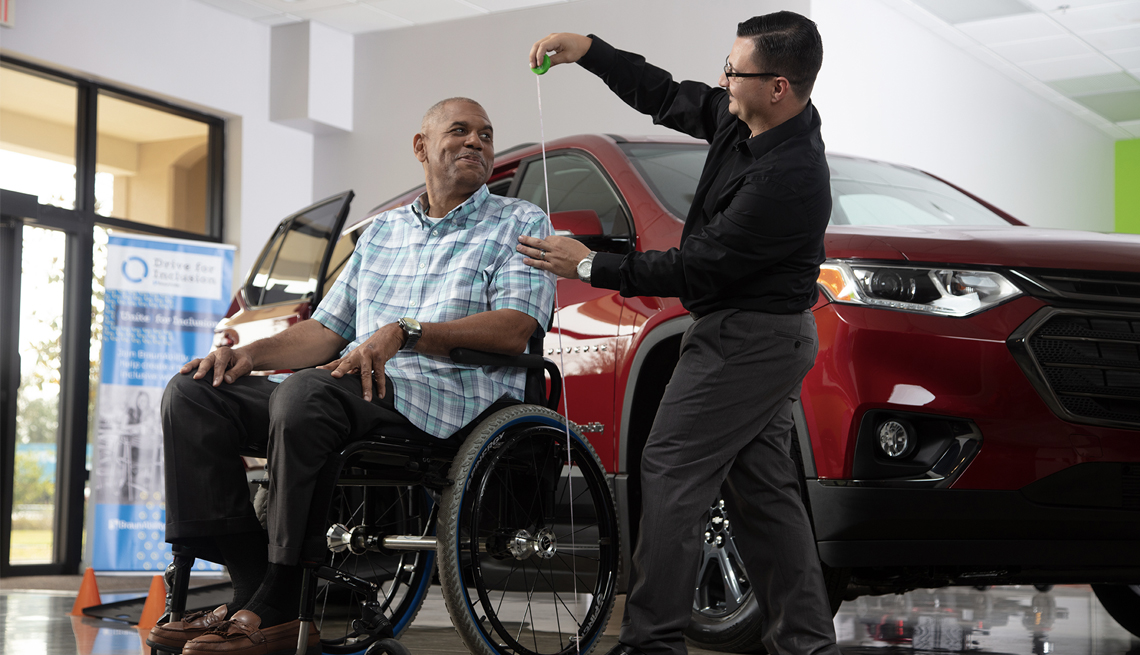
Tips to modify and buy wheelchair accessible vehicles
- Select a language for the TTS:
- UK English Female
- UK English Male
- US English Female
- US English Male
- Australian Female
- Australian Male
- Language selected: (auto detect) - EN
Play all audios:

WC19 chairs come with places to hook the straps, according to UMTRI. If you’re using another kind of chair, attach the hooks only to welded parts of the frame, not adjustable or moving parts
like wheels or foot supports. Basic tie-down kits start at a few hundred dollars, but they can cost considerably more with features like automatic cinching of the strap or attached lap
and shoulder belts. A potentially more expensive but less taxing option is a docking station. With these floor-mounted brackets, there’s no need for a second person to manually secure the
wheelchair. The user rolls the chair into a V-shaped opening that narrows into a slit, under which a lock snaps closed around a bar attached to the bottom of the chair. Pressing a button
electronically releases the chair when the ride is over. Docking stations from the main manufacturers, Q’Straint and EZ Lock, cost around $1,500 with installation. Makers of both tie-down
and docking systems typically sell to distributors of mobility equipment, and that’s where you’ll want to shop. The National Mobility Equipment Dealers Association (NMEDA) offers an online
directory of accredited dealers and installers. Depending on the system you use, the securement setup can be placed in the front passenger seat position, allowing the wheelchair user to
ride “shotgun,” or in rear locations. It’s up to you, but wherever you put the wheelchair hardware, the original car seat has to come out. MODIFIED VEHICLES Getting the wheelchair into
the vehicle is easier if the vehicle has been modified, typically with a lowered floor and built-in ramps. That way, someone using a power wheelchair can motor into the vehicle without help.
Even with a manual chair, the lowered floor means less effort for the user to roll it or for the caregiver to push it up and into place. Outfitting an auto for greater accessibility is a
major commitment. It can cost anywhere from $16,000, to modify a vehicle you already own, to more than $80,000, to buy a new, late-model conversion, according to BraunAbility, which sells
accessible autos and other mobility equipment through a national network of dealers. Most modified vehicles are minivans, which offer the most room inside and already have large sliding
doors that ease wheelchair access. Some dealers offer converted SUVs, but they are generally pricier than vans. Converting an SUV requires replacing a conventional swing-open side door with
a sliding version. BraunAbility’s modified Chevrolet Traverse SUV lists for about $82,000 new. The company’s new converted vans start at around $52,000 but can cost well over $80,000,
depending on the model (choices include Chrysler’s Pacifica and Voyager and the Toyota Sienna) and the ramp location (rear or side entry) and type (fold-out or power operated). At
MobilityWorks, another dealer, older used conversions run from around $25,000 to $60,000. To find a vehicle and design that the mobility industry has reviewed for compliance with federal
safety standards, consult the NMEDA's list of safety-certified models offered by its member dealers. You may be able to get financial help for obtaining a wheelchair-ready vehicle.
“The most robust funding sources are [from the] government,” says Amy Schoppman, director of government relations at the NMEDA. Some states have programs to help residents get mobility
equipment, and military veterans with a service-related disability can apply to the U.S. Department of Veterans Affairs for an auto grant of about $22,000 for the purchase of a specially
equipped vehicle.
